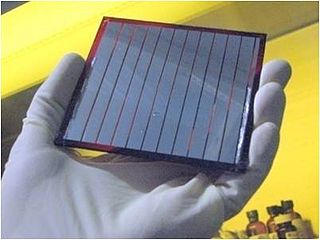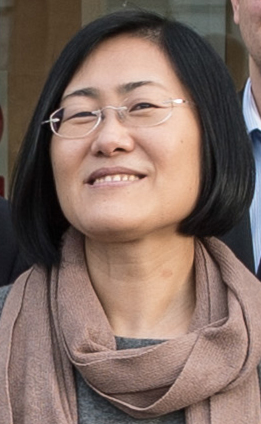Related Research Articles

Organic electronics is a field of materials science concerning the design, synthesis, characterization, and application of organic molecules or polymers that show desirable electronic properties such as conductivity. Unlike conventional inorganic conductors and semiconductors, organic electronic materials are constructed from organic (carbon-based) molecules or polymers using synthetic strategies developed in the context of organic chemistry and polymer chemistry.

An organic light-emitting diode (OLED), also known as organic electroluminescentdiode, is a type of light-emitting diode (LED) in which the emissive electroluminescent layer is an organic compound film that emits light in response to an electric current. This organic layer is situated between two electrodes; typically, at least one of these electrodes is transparent. OLEDs are used to create digital displays in devices such as television screens, computer monitors, and portable systems such as smartphones and handheld game consoles. A major area of research is the development of white OLED devices for use in solid-state lighting applications.

Conductive polymers or, more precisely, intrinsically conducting polymers (ICPs) are organic polymers that conduct electricity. Such compounds may have metallic conductivity or can be semiconductors. The main advantage of conductive polymers is that they are easy to process, mainly by dispersion. Conductive polymers are generally not thermoplastics, i.e., they are not thermoformable. But, like insulating polymers, they are organic materials. They can offer high electrical conductivity but do not show similar mechanical properties to other commercially available polymers. The electrical properties can be fine-tuned using the methods of organic synthesis and by advanced dispersion techniques.
Organic semiconductors are solids whose building blocks are pi-bonded molecules or polymers made up by carbon and hydrogen atoms and – at times – heteroatoms such as nitrogen, sulfur and oxygen. They exist in the form of molecular crystals or amorphous thin films. In general, they are electrical insulators, but become semiconducting when charges are either injected from appropriate electrodes, upon doping or by photoexcitation.

A flexible organic light-emitting diode (FOLED) is a type of organic light-emitting diode (OLED) incorporating a flexible plastic substrate on which the electroluminescent organic semiconductor is deposited. This enables the device to be bent or rolled while still operating. Currently the focus of research in industrial and academic groups, flexible OLEDs form one method of fabricating a rollable display.

Sir Richard Henry Friend is a British physicist who was the Cavendish Professor of Physics at the University of Cambridge from 1995 until 2020 and is Tan Chin Tuan Centennial Professor at the National University of Singapore. Friend's research concerns the physics and engineering of carbon-based semiconductors. He also serves as Chairman of the Scientific Advisory Board of the National Research Foundation (NRF) of Singapore.

Printed electronics is a set of printing methods used to create electrical devices on various substrates. Printing typically uses common printing equipment suitable for defining patterns on material, such as screen printing, flexography, gravure, offset lithography, and inkjet. By electronic-industry standards, these are low-cost processes. Electrically functional electronic or optical inks are deposited on the substrate, creating active or passive devices, such as thin film transistors; capacitors; coils; resistors. Some researchers expect printed electronics to facilitate widespread, very low-cost, low-performance electronics for applications such as flexible displays, smart labels, decorative and animated posters, and active clothing that do not require high performance.

Jean-Luc Brédas is an American chemist, working at the University of Arizona. He was born in Fraire, Belgium, on 23 May 1954.

An organic solar cell (OSC) or plastic solar cell is a type of photovoltaic that uses organic electronics, a branch of electronics that deals with conductive organic polymers or small organic molecules, for light absorption and charge transport to produce electricity from sunlight by the photovoltaic effect. Most organic photovoltaic cells are polymer solar cells.

Dame Athene Margaret Donald is a British physicist. She is Professor Emerita of Experimental Physics at the University of Cambridge, and Master of Churchill College, Cambridge.
A light-emitting electrochemical cell is a solid-state device that generates light from an electric current (electroluminescence). LECs are usually composed of two metal electrodes connected by an organic semiconductor containing mobile ions. Aside from the mobile ions, their structure is very similar to that of an organic light-emitting diode (OLED).

Andrew Bruce Holmes is an Australian and British senior research chemist and professor at the Bio21 Institute, Melbourne, Australia, and the past President of the Australian Academy of Science. His research interests lie in the synthesis of biologically-active natural products and optoelectronic polymers.

Jenny Nelson is Professor of Physics in the Blackett Laboratory and Head of the Climate change mitigation team at the Grantham Institute - Climate Change and Environment at Imperial College London.
Jeremy Henley Burroughes is a British physicist and engineer, known for his contributions to the development of organic electronics through his work on the science of semiconducting polymers and molecules and their application. He is the Chief Technology Officer of Cambridge Display Technology, a company specialising in the development of technologies based on polymer light-emitting diodes.

James Robert DurrantFRSC FLSW is a British photochemist. He is a professor of photochemistry at Imperial College London and Sêr Cymru Solar Professor at Swansea University. He serves as director of the centre for plastic electronics (CPE).

Iain McCulloch is Professor of Polymer Chemistry, in the Department of Chemistry, at the University of Oxford, UK, a fellow and tutor in chemistry at Worcester College, and an adjunct professor at King Abdullah University of Science and Technology (KAUST), Saudi Arabia, and a visiting professor in the Department of Chemistry at Imperial College London.

Ji-Seon Kim is a South Korean physicist. She is a Professor in the Department of Physics and Centre for Plastic Electronics at Imperial College London.
Laura Maria Herz is a professor of physics at the University of Oxford. She works on femtosecond spectroscopy for the analysis of semiconductor materials.

Natalie Stingelin, Fellow of the Materials Research Society and Royal Society of Chemistry, is a materials scientist and current chair of the School of Materials Science and Engineering at the Georgia Institute of Technology, the University of Bordeaux and Imperial College. She led the European Commission Marie Curie INFORM network and is Editor-in-Chief of the Journal of Materials Chemistry C and Materials Advances.

Fred Wudl is an American materials scientist, academic researcher. He is a Professor Emeritus in the Department of Materials Engineering at the University of California, Santa Barbara.
References
- 1 2 Anon (2017). "Bradley, Prof. Donal Donat Conor" . Who's Who (online Oxford University Press ed.). Oxford: A & C Black. doi:10.1093/ww/9780199540884.013.U8468.(Subscription or UK public library membership required.)
- 1 2 Donal Bradley publications indexed by Google Scholar
- ↑ "Centre for Plastic Electronics". 8 March 2024.
- ↑ "2009 Faraday Medal".
- ↑ "2010 Faraday Medal". Archived from the original on 8 January 2013. Retrieved 1 March 2011.
- 1 2 Friend, R. H.; Gymer, R. W.; Holmes, A. B.; Burroughes, J. H.; Marks, R. N.; Taliani, C.; Bradley, D. D. C.; Santos, D. A. Dos; Brédas, J. L.; Lögdlund, M.; Salaneck, W. R. (1999). "Electroluminescence in conjugated polymers". Nature. 397 (6715): 121–128. Bibcode:1999Natur.397..121F. doi:10.1038/16393. ISSN 0028-0836. S2CID 4328634.
- 1 2 Burroughes, J. H.; Bradley, D. D. C.; Brown, A. R.; Marks, R. N.; Mackay, K.; Friend, R. H.; Burns, P. L.; Holmes, A. B. (1990). "Light-emitting diodes based on conjugated polymers". Nature. 347 (6293): 539–541. Bibcode:1990Natur.347..539B. doi:10.1038/347539a0. ISSN 0028-0836. S2CID 43158308.
- ↑ Wade, Jessica; Steiner, Florian; Niedzialek, Dorota; James, David T.; Jung, Youngsuk; Yun, Dong-Jin; Bradley, Donal D. C.; Nelson, Jenny; Kim, Ji-Seon (2014). "Charge mobility anisotropy of functionalized pentacenes in organic field effect transistors fabricated by solution processing". Journal of Materials Chemistry C. 2 (47): 10110–10115. doi:10.1039/C4TC01353K. ISSN 2050-7526.
- ↑ Bradley, Donal D. C. (1987). Spectroscopic investigations of the processible conjugated polymers poly(P-phenylene vinylene) and poly(4,4'-diphenylene diphenyl vinylene). jisc.ac.uk (PhD thesis). University of Cambridge. EThOS uk.bl.ethos.384283.
- ↑ "Electroluminescent devices". Google Patents. 20 April 1989. Retrieved 13 June 2016.
- ↑ Burroughes, J. H.; Bradley, D. D. C.; Brown, A. R.; Marks, R. N.; MacKay, K.; Friend, R. H.; Burns, P. L.; Holmes, A. B. (1990). "Light-emitting diodes based on conjugated polymers" . Nature. 347 (6293): 539–541. Bibcode:1990Natur.347..539B. doi:10.1038/347539a0. S2CID 43158308.
- ↑ "The Economic Benefit of Chemistry Research to the UK". Oxford Economics. September 2010. p. 113.
- ↑ "ISI Highly Cited, Donal Bradley". Archived from the original on 19 May 2007. Retrieved 6 September 2014.
- ↑ "Donal Bradley | University of Oxford Department of Physics". www2.physics.ox.ac.uk. Retrieved 17 August 2018.
- ↑ Adams, Richard (6 March 2018). "Opposition to Oxford USS Debate". TheGuardian.com .
- ↑ @sallylepage (7 March 2018). "Bradley Opposition" (Tweet) – via Twitter.
- ↑ "DONAL D. C. BRADLEY". www.kaust.edu.sa. Retrieved 25 April 2021.
- ↑ "Institution of Engineering and Technology Faraday Medal 2010". Archived from the original on 25 February 2011. Retrieved 6 September 2014.
- ↑ "Institute of Physics Faraday Medal 2009".
- ↑ "Norman's Blog". 11 August 2009. Retrieved 6 September 2014.
- ↑ "Royal Society Brian Mercer Award for Innovation 2007". Archived from the original on 25 July 2011. Retrieved 1 March 2011.
- ↑ "Brian Mercer Award for Innovation, Google Video" . Retrieved 6 September 2014.
- ↑ "Ingenia Online Article" . Retrieved 6 September 2014.
- ↑ "Imperial College London Research Excellence Award 2006" (PDF). Retrieved 6 September 2014.
- ↑ "European Science Foundation European Latsis Prize 2005" (PDF). Retrieved 6 September 2014.[ permanent dead link ]
- ↑ "Quarterly Epic Newsletter for Photonics" (PDF). Retrieved 6 September 2014.[ permanent dead link ]
- ↑ "SID 2005 Programme" (PDF). Archived from the original (PDF) on 5 July 2008. Retrieved 6 September 2014.
- ↑ "Imperial College Jan Rajchman Prize Announcement" . Retrieved 6 September 2014.
- ↑ "Daiwa Award 1994" (PDF). Retrieved 6 September 2014.[ permanent dead link ]
- ↑ "FRS Imperial College Announcement 2004".
- ↑ "No. 59282". The London Gazette (Supplement). 31 December 2009. p. 6.
- ↑ "CBE Announcement Independent". The Independent. London, UK. 31 December 2009. Retrieved 6 September 2014.
- ↑ Palmer, Jason (31 December 2009). "CBE Announcement BBC". BBC News. Retrieved 6 September 2014.
- ↑ "CBE Announcement IoP" . Retrieved 6 September 2014.
- ↑ "The Royal Society Bakerian Lecture 2010" . Retrieved 6 September 2014.
- ↑ "The Institute of Physics Mott Lecture 2009" (PDF). Retrieved 6 September 2014.
- ↑ "Hong Kong Polytechnic University Chau-wai Yin Memorial Lecture 2009". Archived from the original on 21 July 2011. Retrieved 1 March 2011.
- 1 2 Highly Cited, Rankings by Citation
- ↑ "THE list of top 100 material scientists 2000–2010" (PDF). Retrieved 6 September 2014.
- ↑ Pollitt, Michael (6 July 2006). "Bradley profile". The Guardian. London, UK. Retrieved 6 September 2014.
- ↑ "Profile" . Retrieved 6 September 2014.
- ↑ "Bradley profile". BBC News. 9 July 1999. Retrieved 6 September 2014.
- ↑ "Profile at foley.com" (PDF). Archived from the original (PDF) on 11 July 2011. Retrieved 6 September 2014.
- ↑ "Profile". Archived from the original on 9 August 2011. Retrieved 6 September 2014.
- ↑ "House of Commons Innovation, Universities, Science and Skills Committee Engineering: turning ideas into reality. Fourth Report of Session 2008–09, Volume I" (PDF). Retrieved 6 September 2014.
- ↑ "Profile" (PDF). Retrieved 6 September 2014.
- ↑ "Profile" . Retrieved 6 September 2014.
- ↑ "Profile" (PDF). Retrieved 6 September 2014.
- ↑ "Profile" . Retrieved 6 September 2014.[ permanent dead link ]
- ↑ "Optoelectronics Committee". Home (in Latin). Retrieved 11 July 2020.